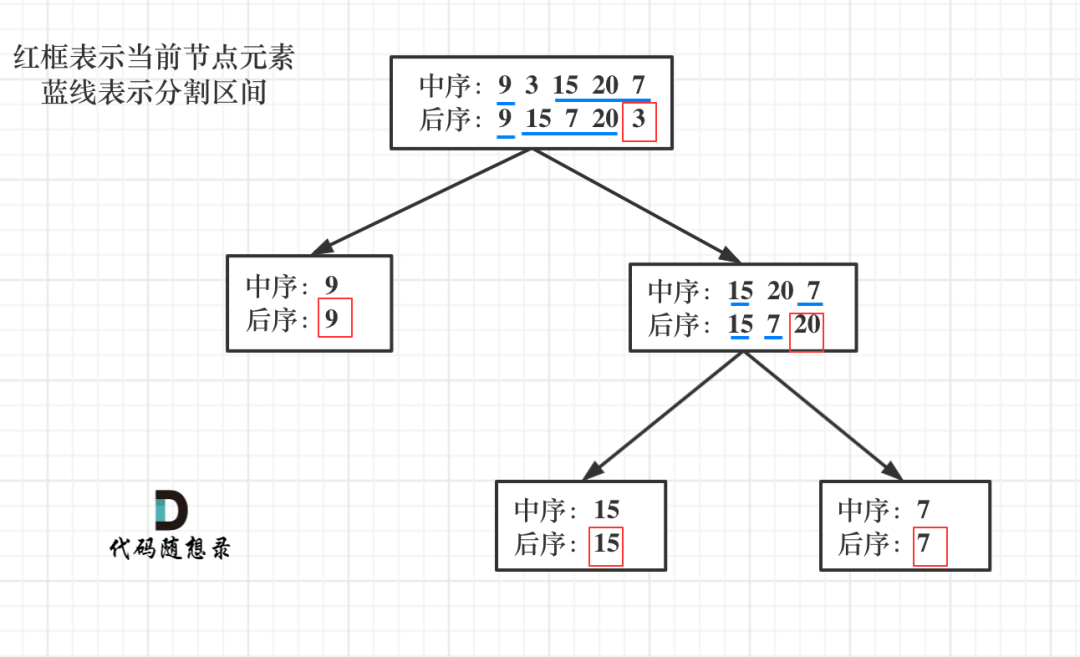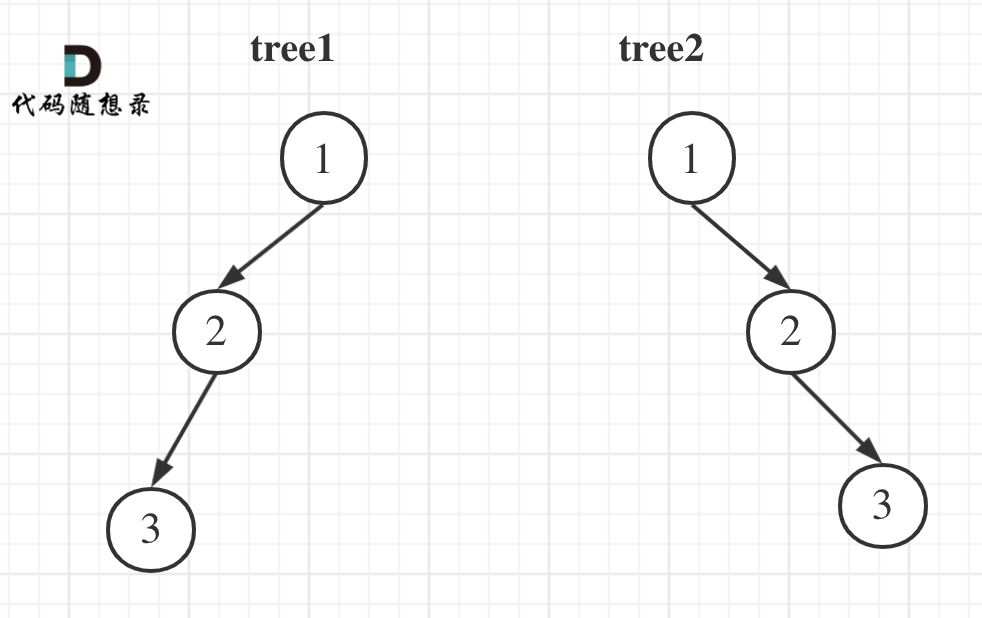看完本文,可以一起解决如下两道题目
- 从中序与后序遍历序列构造二叉树
- 从前序与中序遍历序列构造二叉树
从中序与后序遍历序列构造二叉树题
目地址:https://leetcode-cn.com/problems/construct-binary-tree-from-inorder-and-postorder-traversal/
根据一棵树的中序遍历与后序遍历构造二叉树。
注意: 你可以假设树中没有重复的元素。
例如,给出
中序遍历 inorder = [9,3,15,20,7] 后序遍历 postorder = [9,15,7,20,3] 返回如下的二叉树:

思路
首先回忆一下如何根据两个顺序构造一个唯一的二叉树,相信理论知识大家应该都清楚,就是以 后序数组的最后一个元素为切割点,先切中序数组,根据中序数组,反过来在切后序数组。一层一层切下去,每次后序数组最后一个元素就是节点元素。
如果让我们肉眼看两个序列,画一颗二叉树的话,应该分分钟都可以画出来。
流程如图:

从中序与后序遍历序列构造二叉树
那么代码应该怎么写呢?
说到一层一层切割,就应该想到了递归。
来看一下一共分几步:
- 第一步:如果数组大小为零的话,说明是空节点了。
- 第二步:如果不为空,那么取后序数组最后一个元素作为节点元素。
- 第三步:找到后序数组最后一个元素在中序数组的位置,作为切割点
- 第四步:切割中序数组,切成中序左数组和中序右数组 (顺序别搞反了,一定是先切中序数组)
- 第五步:切割后序数组,切成后序左数组和后序右数组
- 第六步:递归处理左区间和右区间
不难写出如下代码:(先把框架写出来)
- TreeNode* traversal (vector<int>& inorder, vector<int>& postorder) {
- // 第一步
- if (postorder.size() == 0) return NULL;
- // 第二步:后序遍历数组最后一个元素,就是当前的中间节点
- int rootValue = postorder[postorder.size() - 1];
- TreeNode* root = new TreeNode(rootValue);
- // 叶子节点
- if (postorder.size() == 1) return root;
- // 第三步:找切割点
- int delimiterIndex;
- for (delimiterIndex = 0; delimiterIndex < inorder.size(); delimiterIndex++) {
- if (inorder[delimiterIndex] == rootValue) break;
- }
- // 第四步:切割中序数组,得到 中序左数组和中序右数组
- // 第五步:切割后序数组,得到 后序左数组和后序右数组
- // 第六步
- root->left = traversal(中序左数组, 后序左数组);
- root->right = traversal(中序右数组, 后序右数组);
- return root;
- }
难点大家应该发现了,就是如何切割,以及边界值找不好很容易乱套。
此时应该注意确定切割的标准,是左闭右开,还有左开又闭,还是左闭又闭,这个就是不变量,要在递归中保持这个不变量。
在切割的过程中会产生四个区间,把握不好不变量的话,一会左闭右开,一会左闭又闭,必然乱套!
我在704.二分查找和59.螺旋矩阵II中都强调过循环不变量的重要性,在二分查找以及螺旋矩阵的求解中,坚持循环不变量非常重要,本题也是。
首先要切割中序数组,为什么先切割中序数组呢?
切割点在后序数组的最后一个元素,就是用这个元素来切割中序数组的,所以必要先切割中序数组。
中序数组相对比较好切,找到切割点(后序数组的最后一个元素)在中序数组的位置,然后切割,如下代码中我坚持左闭右开的原则:
- // 找到中序遍历的切割点
- int delimiterIndex;
- for (delimiterIndex = 0; delimiterIndex < inorder.size(); delimiterIndex++) {
- if (inorder[delimiterIndex] == rootValue) break;
- }
- // 左闭右开区间:[0, delimiterIndex)
- vector<int> leftInorder(inorder.begin(), inorder.begin() + delimiterIndex);
- // [delimiterIndex + 1, end)
- vector<int> rightInorder(inorder.begin() + delimiterIndex + 1, inorder.end() );
接下来就要切割后序数组了。
首先后序数组的最后一个元素指定不能要了,这是切割点 也是 当前二叉树中间节点的元素,已经用了。
后序数组的切割点怎么找?
后序数组没有明确的切割元素来进行左右切割,不像中序数组有明确的切割点,切割点左右分开就可以了。
此时有一个很重的点,就是中序数组大小一定是和后序数组的大小相同的(这是必然)。
中序数组我们都切成了左中序数组和右中序数组了,那么后序数组就可以按照左中序数组的大小来切割,切成左后序数组和右后序数组。
代码如下:
- // postorder 舍弃末尾元素,因为这个元素就是中间节点,已经用过了
- postorder.resize(postorder.size() - 1);
- // 左闭右开,注意这里使用了左中序数组大小作为切割点:[0, leftInorder.size)
- vector<int> leftPostorder(postorder.begin(), postorder.begin() + leftInorder.size());
- // [leftInorder.size(), end)
- vector<int> rightPostorder(postorder.begin() + leftInorder.size(), postorder.end());
此时,中序数组切成了左中序数组和右中序数组,后序数组切割成左后序数组和右后序数组。
接下来可以递归了,代码如下:
- root->left = traversal(leftInorder, leftPostorder);
- root->right = traversal(rightInorder, rightPostorder);
完整代码如下:
C++完整代码
- class Solution {
- private:
- TreeNode* traversal (vector<int>& inorder, vector<int>& postorder) {
- if (postorder.size() == 0) return NULL;
- // 后序遍历数组最后一个元素,就是当前的中间节点
- int rootValue = postorder[postorder.size() - 1];
- TreeNode* root = new TreeNode(rootValue);
- // 叶子节点
- if (postorder.size() == 1) return root;
- // 找到中序遍历的切割点
- int delimiterIndex;
- for (delimiterIndex = 0; delimiterIndex < inorder.size(); delimiterIndex++) {
- if (inorder[delimiterIndex] == rootValue) break;
- }
- // 切割中序数组
- // 左闭右开区间:[0, delimiterIndex)
- vector<int> leftInorder(inorder.begin(), inorder.begin() + delimiterIndex);
- // [delimiterIndex + 1, end)
- vector<int> rightInorder(inorder.begin() + delimiterIndex + 1, inorder.end() );
- // postorder 舍弃末尾元素
- postorder.resize(postorder.size() - 1);
- // 切割后序数组
- // 依然左闭右开,注意这里使用了左中序数组大小作为切割点
- // [0, leftInorder.size)
- vector<int> leftPostorder(postorder.begin(), postorder.begin() + leftInorder.size());
- // [leftInorder.size(), end)
- vector<int> rightPostorder(postorder.begin() + leftInorder.size(), postorder.end());
- root->left = traversal(leftInorder, leftPostorder);
- root->right = traversal(rightInorder, rightPostorder);
- return root;
- }
- public:
- TreeNode* buildTree(vector<int>& inorder, vector<int>& postorder) {
- if (inorder.size() == 0 || postorder.size() == 0) return NULL;
- return traversal(inorder, postorder);
- }
- };
相信大家自己就算是思路清晰, 代码写出来一定是各种问题,所以一定要加日志来调试,看看是不是按照自己思路来切割的,不要大脑模拟,那样越想越糊涂。
下面给出用下表索引写出的代码版本:(思路是一样的,只不过不用重复定义vector了,每次用下表索引来分割)
C++优化版本
那么这个版本写出来依然要打日志进行调试,打日志的版本如下:(该版本不要在leetcode上提交,容易超时)
- class Solution {
- private:
- TreeNode* traversal (vector<int>& inorder, int inorderBegin, int inorderEnd, vector<int>& postorder, int postorderBegin, int postorderEnd) {
- if (postorderBegin == postorderEnd) return NULL;
- int rootValue = postorder[postorderEnd - 1];
- TreeNode* root = new TreeNode(rootValue);
- if (postorderEnd - postorderBegin == 1) return root;
- int delimiterIndex;
- for (delimiterIndex = inorderBegin; delimiterIndex < inorderEnd; delimiterIndex++) {
- if (inorder[delimiterIndex] == rootValue) break;
- }
- // 切割中序数组
- // 左中序区间,左闭右开[leftInorderBegin, leftInorderEnd)
- int leftInorderBegin = inorderBegin;
- int leftInorderEnd = delimiterIndex;
- // 右中序区间,左闭右开[rightInorderBegin, rightInorderEnd)
- int rightInorderBegin = delimiterIndex + 1;
- int rightInorderEnd = inorderEnd;
- // 切割后序数组
- // 左后序区间,左闭右开[leftPostorderBegin, leftPostorderEnd)
- int leftPostorderBegin = postorderBegin;
- int leftPostorderEnd = postorderBegin + delimiterIndex - inorderBegin; // 终止位置是 需要加上 中序区间的大小size
- // 右后序区间,左闭右开[rightPostorderBegin, rightPostorderEnd)
- int rightPostorderBegin = postorderBegin + (delimiterIndex - inorderBegin);
- int rightPostorderEnd = postorderEnd - 1; // 排除最后一个元素,已经作为节点了
- cout << "----------" << endl;
- cout << "leftInorder :";
- for (int i = leftInorderBegin; i < leftInorderEnd; i++) {
- cout << inorder[i] << " ";
- }
- cout << endl;
- cout << "rightInorder :";
- for (int i = rightInorderBegin; i < rightInorderEnd; i++) {
- cout << inorder[i] << " ";
- }
- cout << endl;
- cout << "leftpostorder :";
- for (int i = leftPostorderBegin; i < leftPostorderEnd; i++) {
- cout << postorder[i] << " ";
- }
- cout << endl;
- cout << "rightpostorder :";
- for (int i = rightPostorderBegin; i < rightPostorderEnd; i++) {
- cout << postorder[i] << " ";
- }
- cout << endl;
- root->left = traversal(inorder, leftInorderBegin, leftInorderEnd, postorder, leftPostorderBegin, leftPostorderEnd);
- root->right = traversal(inorder, rightInorderBegin, rightInorderEnd, postorder, rightPostorderBegin, rightPostorderEnd);
- return root;
- }
- public:
- TreeNode* buildTree(vector<int>& inorder, vector<int>& postorder) {
- if (inorder.size() == 0 || postorder.size() == 0) return NULL;
- return traversal(inorder, 0, inorder.size(), postorder, 0, postorder.size());
- }
- };
从前序与中序遍历序列构造二叉树
题目地址:https://leetcode-cn.com/problems/construct-binary-tree-from-preorder-and-inorder-traversal/
根据一棵树的前序遍历与中序遍历构造二叉树。
注意: 你可以假设树中没有重复的元素。
例如,给出
前序遍历 preorder = [3,9,20,15,7] 中序遍历 inorder = [9,3,15,20,7] 返回如下的二叉树:

从前序与中序遍历序列构造二叉树
思路
本题和106是一样的道理。
我就直接给出代码了。
- class Solution {
- private:
- TreeNode* traversal (vector<int>& inorder, int inorderBegin, int inorderEnd, vector<int>& preorder, int preorderBegin, int preorderEnd) {
- if (preorderBegin == preorderEnd) return NULL;
- int rootValue = preorder[preorderBegin]; // 注意用preorderBegin 不要用0
- TreeNode* root = new TreeNode(rootValue);
- if (preorderEnd - preorderBegin == 1) return root;
- int delimiterIndex;
- for (delimiterIndex = inorderBegin; delimiterIndex < inorderEnd; delimiterIndex++) {
- if (inorder[delimiterIndex] == rootValue) break;
- }
- // 切割中序数组
- // 中序左区间,左闭右开[leftInorderBegin, leftInorderEnd)
- int leftInorderBegin = inorderBegin;
- int leftInorderEnd = delimiterIndex;
- // 中序右区间,左闭右开[rightInorderBegin, rightInorderEnd)
- int rightInorderBegin = delimiterIndex + 1;
- int rightInorderEnd = inorderEnd;
- // 切割前序数组
- // 前序左区间,左闭右开[leftPreorderBegin, leftPreorderEnd)
- int leftPreorderBegin = preorderBegin + 1;
- int leftPreorderEnd = preorderBegin + 1 + delimiterIndex - inorderBegin; // 终止位置是起始位置加上中序左区间的大小size
- // 前序右区间, 左闭右开[rightPreorderBegin, rightPreorderEnd)
- int rightPreorderBegin = preorderBegin + 1 + (delimiterIndex - inorderBegin);
- int rightPreorderEnd = preorderEnd;
- root->left = traversal(inorder, leftInorderBegin, leftInorderEnd, preorder, leftPreorderBegin, leftPreorderEnd);
- root->right = traversal(inorder, rightInorderBegin, rightInorderEnd, preorder, rightPreorderBegin, rightPreorderEnd);
- return root;
- }
- public:
- TreeNode* buildTree(vector<int>& preorder, vector<int>& inorder) {
- if (inorder.size() == 0 || preorder.size() == 0) return NULL;
- // 参数坚持左闭右开的原则
- return traversal(inorder, 0, inorder.size(), preorder, 0, preorder.size());
- }
- };
思考题
前序和中序可以唯一确定一颗二叉树。
后序和中序可以唯一确定一颗二叉树。
那么前序和后序可不可以唯一确定一颗二叉树呢?
前序和后序不能唯一确定一颗二叉树!,因为没有中序遍历无法确定左右部分,也就是无法分割。
举一个例子:

从中序与后序遍历序列构造二叉树2
tree1 的前序遍历是[1 2 3], 后序遍历是[3 2 1]。
tree2 的前序遍历是[1 2 3], 后序遍历是[3 2 1]。
那么tree1 和 tree2 的前序和后序完全相同,这是一棵树么,很明显是两棵树!
所以前序和后序不能唯一确定一颗二叉树!
总结
之前我们讲的二叉树题目都是各种遍历二叉树,这次开始构造二叉树了,思路其实比较简单,但是真正代码实现出来并不容易。
所以要避免眼高手低,踏实的把代码写出来。
我同时给出了添加日志的代码版本,因为这种题目是不太容易写出来调一调就能过的,所以一定要把流程日志打出来,看看符不符合自己的思路。
大家遇到这种题目的时候,也要学会打日志来调试(如何打日志有时候也是个技术活),不要脑动模拟,脑动模拟很容易越想越乱。
最后我还给出了为什么前序和中序可以唯一确定一颗二叉树,后序和中序可以唯一确定一颗二叉树,而前序和后序却不行。
认真研究完本篇,相信大家对二叉树的构造会清晰很多。
其他语言版本
Java
从中序与后序遍历序列构造二叉树
- class Solution {
- public TreeNode buildTree(int[] inorder, int[] postorder) {
- return buildTree1(inorder, 0, inorder.length, postorder, 0, postorder.length);
- }
- public TreeNode buildTree1(int[] inorder, int inLeft, int inRight,
- int[] postorder, int postLeft, int postRight) {
- // 没有元素了
- if (inRight - inLeft < 1) {
- return null;
- }
- // 只有一个元素了
- if (inRight - inLeft == 1) {
- return new TreeNode(inorder[inLeft]);
- }
- // 后序数组postorder里最后一个即为根结点
- int rootVal = postorder[postRight - 1];
- TreeNode root = new TreeNode(rootVal);
- int rootIndex = 0;
- // 根据根结点的值找到该值在中序数组inorder里的位置
- for (int i = inLeft; i < inRight; i++) {
- if (inorder[i] == rootVal) {
- rootIndex = i;
- }
- }
- // 根据rootIndex划分左右子树
- root.left = buildTree1(inorder, inLeft, rootIndex,
- postorder, postLeft, postLeft + (rootIndex - inLeft));
- root.right = buildTree1(inorder, rootIndex + 1, inRight,
- postorder, postLeft + (rootIndex - inLeft), postRight - 1);
- return root;
- }
- }
从前序与中序遍历序列构造二叉树
- class Solution {
- public TreeNode buildTree(int[] preorder, int[] inorder) {
- return helper(preorder, 0, preorder.length - 1, inorder, 0, inorder.length - 1);
- }
- public TreeNode helper(int[] preorder, int preLeft, int preRight,
- int[] inorder, int inLeft, int inRight) {
- // 递归终止条件
- if (inLeft > inRight || preLeft > preRight) return null;
- // val 为前序遍历第一个的值,也即是根节点的值
- // idx 为根据根节点的值来找中序遍历的下标
- int idx = inLeft, val = preorder[preLeft];
- TreeNode root = new TreeNode(val);
- for (int i = inLeft; i <= inRight; i++) {
- if (inorder[i] == val) {
- idx = i;
- break;
- }
- }
- // 根据 idx 来递归找左右子树
- root.left = helper(preorder, preLeft + 1, preLeft + (idx - inLeft),
- inorder, inLeft, idx - 1);
- root.right = helper(preorder, preLeft + (idx - inLeft) + 1, preRight,
- inorder, idx + 1, inRight);
- return root;
- }
- }
Python
从前序与中序遍历序列构造二叉树
- class Solution:
- def buildTree(self, preorder: List[int], inorder: List[int]) -> TreeNode:
- # 第一步: 特殊情况讨论: 树为空. 或者说是递归终止条件
- if not preorder:
- return None
- # 第二步: 前序遍历的第一个就是当前的中间节点.
- root_val = preorder[0]
- root = TreeNode(root_val)
- # 第三步: 找切割点.
- separator_idx = inorder.index(root_val)
- # 第四步: 切割inorder数组. 得到inorder数组的左,右半边.
- inorder_left = inorder[:separator_idx]
- inorder_right = inorder[separator_idx + 1:]
- # 第五步: 切割preorder数组. 得到preorder数组的左,右半边.
- # ⭐️ 重点1: 中序数组大小一定跟前序数组大小是相同的.
- preorder_left = preorder[1:1 + len(inorder_left)]
- preorder_right = preorder[1 + len(inorder_left):]
- # 第六步: 递归
- root.left = self.buildTree(preorder_left, inorder_left)
- root.right = self.buildTree(preorder_right, inorder_right)
- return root
从中序与后序遍历序列构造二叉树
- class Solution:
- def buildTree(self, inorder: List[int], postorder: List[int]) -> TreeNode:
- # 第一步: 特殊情况讨论: 树为空. (递归终止条件)
- if not postorder:
- return None
- # 第二步: 后序遍历的最后一个就是当前的中间节点.
- root_val = postorder[-1]
- root = TreeNode(root_val)
- # 第三步: 找切割点.
- separator_idx = inorder.index(root_val)
- # 第四步: 切割inorder数组. 得到inorder数组的左,右半边.
- inorder_left = inorder[:separator_idx]
- inorder_right = inorder[separator_idx + 1:]
- # 第五步: 切割postorder数组. 得到postorder数组的左,右半边.
- # ⭐️ 重点1: 中序数组大小一定跟后序数组大小是相同的.
- postorder_left = postorder[:len(inorder_left)]
- postorder_right = postorder[len(inorder_left): len(postorder) - 1]
- # 第六步: 递归
- root.left = self.buildTree(inorder_left, postorder_left)
- root.right = self.buildTree(inorder_right, postorder_right)
- return root































